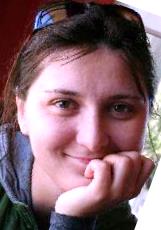Spirit Wrestlers of Southern Russia
Russian Life, Sept/Oct 2005, pages 34-40Story and photos by Dr. Maria Mikhailovna Kolesnikova.
Abstract: Not many hints remain of Doukhobor culture in Southern Russia. Persecuted in the past for their pacifist beliefs, modern Doukhobors search for an identity in the modern world.
See early versions of this article posted on weblogs at New York University, RAJI (Russian-American Journalism Institute):
- 2003 July
9 — Searching
for
a Dying Culture, by Maria Kolesnikova,
- 2004
October 15 — Doukhobors:
The
Last
Generation?, by Maria Kolesnikova
- 2004 October 15 — Doukhobors: The Last Generation?, by Gretchen Weber
- 2005 June
26 — Doukhobors:
The
Last
Generation?, by Maria Kolesnikova (not
archived)
- 2005 June 26 — Doukhobors: The Last Generation?, by Gretchen Weber (not archived)
RAJI
is a collaboration between journalism departments at
Rostov State University and New York University. 2006,
year 4, appears to have been its last active year.
Few in Russia remember the Doukhobors, the pacifist Russian Christian sect championed by Leo Tolstoy over a century ago. In fact, even the name Doukhobor evokes little reaction.
"It sounds funny. Perhaps it is an evil house spirit?" guessed Mikhail Grishin, 20, an engineering student in Rostov-on-Don. His grandmother, Maria Grishina, 80, a retired schoolteacher, does no better. "Doukhobor sounds like doushegub [murderer]," she said. Natalia Trifonova, a Rostov University professor, knows of the Doukhobors. "But they are all gone now," she noted. "To find them you should go to Canada.
"In fact, the Doukhobors are not all gone. An estimated 40,000 still live in Russia and the countries of the former Soviet Union. About the same number live in Western Canada, and a few hundred live in the U.S., according to Koozma Tarasoff, a Canadian historian of the Doukhobors and author of 12 books and hundreds of articles about their culture. Scattered around Russia, Doukhobor populations are centered in the Tselina region in Rostov oblast, Cherns region in Tula oblast, near Blagoveshchensk in Amur oblast and the Mirnoye settlement near Bryansk.
Doukhobors (Doukhobory in Russian), literally means "spirit wrestlers." It was a name bestowed on the sect — which had previously been known as Ikonobory ("icon fighters") — by a Russian Orthodox Church priest (originally, the epithet was Doukhobortsy — "wrestlers against the Holy Spirit" — and intended as an insult, but the members of the sect changed it to the more positive Doukhobors, which implies a wrestling with the Holy Spirit). The sect has its roots in the 1650s, when Patriarch Nikon's reforms of the Russian Orthodox Church led to the Raskol, the Great Schism. Some of the schismatics [raskolniks], called Popovtsi ("Priesters") sought a return to pre-reform traditions, eventually giving way to the movement known as Old Believers. Others, called Bezpopovtsi ("priestless"), argued for dispensing entirely with priests. Some went further still, rejecting icons, sacraments, the divinity of Christ and even the Bible. They became precursors of the Doukhobors, who developed into a distinct religious group by the early 18th century.
The notion of God within each individual is the cornerstone of Doukhobor belief "This philosophy has no creeds and does not need any Bible, Church, icons, or priests to fulfill its needs," Tarasoff explained. "From this notion, we support the moral imperative that we cannot kill another human being — because then we would be killing the spark of God in us. The creation of a non-killing society is the essential quest of the Doukhobors."
Not surprisingly, Russia's tsars saw such pacifism as a threat, as something that could undermine social order and lead to rebellion. As a result, the Doukhobors suffered through centuries of persecution and three major resettlements. Under Tsar Alexander I, they were moved to Molochnye Vody, on the border between Ukraine and Russia. Under Nicholas I, they were exiled to Transcaucasia, along the border of Georgia and Turkey. There, in 1895, the Doukhobors refused to fight in Russia’s war with Turkey, burning all their weapons in a symbolic protest against war and militarism.
The furious tsar ordered that the Doukhobors be scattered throughout Transcaucasia, "sending the father to one village, the mother to another and their children to yet a different village," according to Doukhobor lore [oral history]. The Doukhobors pleaded for help. It came from Quakers in the United States, who shared many beliefs with the Doukhobors, most notably pacifism and anticlericalism. And it came from the Russian writer Leo Tolstoy, whose own personal philosophy had, by this time, gravitated into non-violence. Tolstoy called the Doukhobors a "people of the 25th century." The Doukhobors, for their part, called Tolstoy "our father," after he donated $17,000 from the publication of his book Resurrection to help pay for emigration of some 7,500 Doukhobors to Canada in 1898. Despite this mass emigration, the majority of Doukhobors remained; many moved to Southern Russia after the Bolshevik Revolution in 1917. [For more 1800s history, see Breyfogle and Klibanov.]
Tselina region, Rostov Oblast
My quest for the Doukhobors takes me to Petrovka, a village in Tselina region, about 100 miles southeast of Rostov-on-Don. In 1921, some 4,000 Doukhobors were permitted to resettle here, establishing 21 villages (consolidated to 11 in the 1950s). Today, there are just six Doukhobor villages. Petrovka is the largest and it is by no means exclusively Doukhobor. Other inhabitants include Russian Orthodox, Armenians and Meskhetian Turks, who fled from Uzbekistan after the collapse of the Soviet Union.
Farther into the country, the asphalt road turns to dirt and cows mindlessly collaborate in the creation of a traffic jam. By the time I reach Petrovka, the dirt road has turned to mud.
Regional administrator Lyudmila Nikitina — my guide in Petrovka — offers a disapproving glance at my sandals as she dons her rubber boots. As we splash together through the mud, she explains that Doukhobors still comprise about half of the village's declining population of 300. "It's not as good as it used to be," Nikitina says. "Young people cant find jobs here and they have to leave."
I examine the streets of Petrovka, looking for traces of Doukhobor culture. Most houses appear to have porches bordered with columns, their whitewashed siding shyly hiding behind trees in the yards. On some, sheds and hen houses share a roof with the house itself. These are traditional Doukhobor homes. Newer ones use brick and have no porches, Some of the houses are well kept; some are shabby; some are deserted. The streets seem empty, with only two or three middle-aged women digging in their gardens. There are few children and men.
We approach one of the women. "You are a Doukhobor, aren’t you?" I ask. She seems proud. "Yes, I'm a pureblood," she replies. She invites us into her house, to see a typical Doukhobor interior of three rooms with papered walls. "It's more fashionable today than whitewash, as prescribed by tradition," she explains. The house has painted floors, several wardrobes made in the 1970s, a television and lots of embroidery. It smells of ripe apples.
Our hostess is Tatyana Yuritsina, a social worker in Petrovka. "Doukhobors are the nicest, the most hospitable people," she says. "Now there are many refugees and many people of different religions here. But we have no trouble with them."
Yet, life carries on and the Doukhobors are changing. "We used to live without fences," Yuritsina says. "And the young, they don't want to follow Doukhobor traditions. Take my daughter. She's 25, and she won't listen to me, won't stick to the tradition." Yuritsina speculates that her generation may be the last of the "true Doukhobors," because only older members are clinging to their roots.
Many Doukhobors now marry outside the sect. Yuritsina's husband Vasily is Ukrainian; she says she met him in Rostov and brought him back to Petrovka. "I don’t mind Doukhobors," he says. "They are people, just like everyone else. And the religion isn't important in the long run. You have to believe in God and not sin. That's all."
[Similiar statements can be made about the neighboring Molokans. The loss of Molokan youth was evident in the Summer of 1992 when I visited nearly all the Molokan villages in Tselinski region with Vasili Sissoyev (pomoshnik presbyter, LA-Persian Church), and John & Manya Bogdanoff and their 2 oldest kids. We traveled with T.V. Schetinkin, senior presbyter of the Molokan Center and 3 other lead singers.
The Molokan youth in rural Rostov had mostly moved to the cities for college and work. Even though many had married other Molokans from the same villages, they knew very little about the faith of their parents. Before 1990, the parents were afraid to expose their their kids to their illegal religion. Most of the men were ashamed, or intimidated by others, to attend services, which were primarily run by women. Some congregations were totally women, with women presbytera. The largest congregation was mostly Orthodox women who joined the Molokans because they preferred the Molokan ways and services. This congregation's lead singer was a former Orthodox whose brother was the local Preist!
In 2005, the lack of interest of the youth to adhere to Molokanism is still a major concern, and was one of the talking points presented in July at the 200th Anniversary Congress — "Molokans are seriously worried about ... aging of congregations". ]
Museum of Doukhobor Culture and Worship
The Museum of Doukhobor Culture and Worship is a small home dating to the 1950s which was turned into a museum in 1991, thanks to a donation from the local collective farm, Lenin Kolkhoz. It has a collection of Doukhobor artifacts and serves as a place of worship for a few of Petrovka’s active Doukhobors.
Today, a dozen Doukhobor women have assembled in the living room, the largest room in the house. Its walls are adorned with embroidered towels and traditional costumes. A table in the far right corner holds a bust of Lev Tolstoy and albums with black and white photographs of community members. On the wall are portraits of two Doukhobor leaders, Lukeria Kalmykova and Peter P Verigin.
The Doukhobor women greet us with a traditional hymn. They are wearing long skirts with fancy, embroidered aprons, colorful blouses and white kerchiefs. Some of their attire comes from their grandmothers; some was adapted from the contemporary clothing bought at a local market. it is the sort of clothing no longer worn in everyday life.
"If you dress Doukhobor style and walk along the streets, people will look at you as if you were a savage," says Yevdokia Bulanova, 75, a Doukhobor who lives in the village of Khlebodarnoye, five miles from Petrovka. [Khlebodarnoye from khleb (хлеб = bread, wheat) and dar (conjegation of дасть = to give): "a place that give us wheat" ]
The women in front of me walked to the museum wearing their regular dresses. They carried their traditional Doukhobor costumes in plastic bags, then changed at the museum, like schoolchildren for a class drama performance. But the reality is that they came here to perform, and they like it.
Their singing seems to erase years of worry and woe from their faces. They have a certain ethereal solemnity. The words of the hymns are hard to make out, enhancing the impression that they are protecting some hidden truths. But the explanation is more banal. Years of persecution made Doukhobors in Russia drawl their syllables when singing, so that outsiders could not understand their meaning, says Lyudmila Borisova, 66, a choir member and Doukhobor activist. "Canadian Doukhobors sing much faster," she says, "and one can actually make out the words." Once they have started, the women do not want to stop. Their singing goes on and on. They forget about their hardships, miniscule pensions, cows that need milking, or water that only runs out of the tap a couple of hours each day.
Petrovka's Doukhobor choir once was quite well known. Ethnographers came from Rostov and Moscow to record them singing their traditional hymns and psalms. The choir even toured Rostovskaya and neighboring provinces during the 1995-1998 centennial celebrations of Doukhobor heritage. But the choir doesn’t travel anymore. "People are scattered," Borisova says. "We used to have a big choir, but now maybe only a dozen people remain." Some left the village, some are too old to travel, and some are dead.
"Young people don’t come to our meetings," Borisova says. "They are busy working and don’t have time."
Vera Guzheva, 44, is an exception. Guzheva, who lives in the city of Taganrog, about 170 miles northwest of Petrovka, came to the meeting with her mother, Vera Safonova, who is 77. "My mother is a Doukhobor, but I'm not," says Guzheva. "Our generation doesn't even know who we are."
The other women at the meeting hiss in protest.
"I've lived in the city for 25 years, I am not a Doukhobor anymore," Guzheva responds.
"Who are you then? You are not a Ukrainian, you are not a Belorussian, you are a Doukhobor," Borisova asserts.
"No one in the city knows the Doukhobors. How will I explain to people who I am?"
"You don’t need to tell them, you just have to know in your soul that you are a Doukhobor," Borisova says.
After moving to Taganrog [next to Rostov-on-Don], Guzheva had changed to Russian Orthodoxy, thinking it was more convenient than living as a Doukhobor. During her baptismal, the priest corrected her, saying that the right name of the religion she was giving up was Doukhobortsy, not Doukhobors, a fact she didn't know. "But in my soul I'm a Christian and a Doukhobor," Guzheva says.
Oral History
Doukhobors in Petrovka nourish Doukhobor legends and revere names like Lukeria Kalmykova and Peter P Verigin. They remember the rituals, and, during their meetings on major holidays — Christmas, Whitsunday, Easter and St. Peter's Day — they each read a psalm and then all perform a low bow, even though some of the women now need help standing up afterwards. But ask them to explain the essence o their belief and daily traditions, and they may give you a puzzled look.
There is an awkward silence when I pose this question while visiting the village of Khlebodarnoye. Yevdokia Bulanova finally speaks. "We have our Zhivotnaya Kniga [Book of Life], and you can read something about it there," she suggests. "Nadezhda, bring it here."
Nadezhda Trofimenko, whose home we are visiting, disappears behind the curtain separating the bedroom and living room, and returns with an old, leather-bound book, which she sets down carefully. "This is the principal Doukhobor document, here you'll find everything," Trofimenko says.
The Doukhobor Book of Life is the primary written artifact of Doukhobor heritage, which had been transmitted orally before 1899. Compiled by the Russian ethnographer Vladimir Bonch Bruevich while spending nearly a year in Canada transcribing Doukhobor psalms and hymns, the Book of Life preserves Doukhobor oral history and serves as a bible of their faith.
Dr. Vladimir Kuchin, 63, a researcher at Rostov-on-Don’s Anti Plague Institute, has lived in Rostov since 1958. He is a Doukhobor, and in his tiny studio apartment on the city outskirts, he archives a complete collection of the back issues of Iskra — the Canadian published Doukhobor magazine. He also stores trunk-loads of Doukhobor recordings and artifacts, which he has been collecting since 1975. He frequently contributes to local papers and to Iskra, and he said he is thinking about writing a book on Doukhobor heritage. But he must wonder whom he would be writing for. His own brother and sister have expressed no interest in their Doukhobor roots. And his parents, when they were alive, worried about his fervor for Doukhoboriana. "Dear son, why do you need all this?" they used to ask.
Kuchin's grandparents moved to the Tselina region in 1922. They were in their thirties; his father was 10 and his mother was 8 at the time. At first, people lived in sod houses — 30 people in each home. "Their life was hard, but full of wisdom, patience and good spirit," Kuchin says. When the Soviet state started putting up collective farms (kolkhozy), the first Doukhobor kolkhoz — Obshy Trud [Joint Labor] was set up in Petrovka, headed by Peter P. Verigin. There followed a kolkhoz named after the military commander Vasily Chapayev, and then six Doukhobor villages were united in another kolkhoz named after Vladimir Lenin. In 1928, Doukhobors in the Soviet Union dropped their stricture against army service. "There was no other way to survive," Kuchin says. For the most part, the Doukhobors lived an uneasy peace with the atheistic Soviet State. The government was tacitly permissive toward their religion, as long as the Doukhobors did not openly profess it. [The neighboring Molokan kolkhoz is named after the first cosmonaut Yuri Gagarin.]
Certainly many Doukhobors were imprisoned and exiled under Stalin. Kuchin recalls one story from Petrovka which reflects the insanity of the times. A villager, Fyodor Tomilin, made a chest for his little daughter's toys and instruments and decorated it with a newspaper clipping that featured, among other things, a picture of Marshal Mikhail Tukhachevsky, a prominent Soviet military leader arrested and executed in 1937 on trumped-up charges of treason. Some time later, another villager, Koozma Pereverzev, stopped by to borrow some tools. On his way out, Pereverzev said, "Such a young guy, and already a marshal." Tomilin had no idea what Pereverzev was talking about. Ten days later, Tomilin was arrested and accused of treason along with Tukhachevsky and his supporters. He was sentenced to 10 years in prison. Tomilin insisted that he did not have any idea who Tukhachevsky was, and that no one by this name lived in this village. Only after several years in prison, when he saw Tukhachevsky's photo somewhere else, did he understand what had happened.
In the 1960s, political liberalization allowed the Doukhobors to be open about their beliefs. "I left my home village in 1958, when I entered Rostov State Medical Institute," Kuchin says. "Even then I didn’t conceal my religion from my friends."
Unfortunately for the Doukhobors, Kuchin’s example was becoming more typical. The youth left the village for the cities, where they studied, worked, lived, got married and had children. Many married people outside their religion, often assimilating into Russian Orthodoxy. In bigger cities, like Rostov, Doukhobors no longer gather to sing psalms. "Canadian [Doukhobor] visits might stir people up," Kuchin says. "Some people would meet at Whitsunday, St. Peter's day, and Christmas.
"Kuchin says he used to go to Petrovka quite frequently, until his father died in 1999. But he does not go any longer. It is too painful. "The things that have been happening since the 1980s and 1990s are incredible and I can hardly find the right words," he says. "Prosperous Doukhobor villages in Tselinsky and Bogdanovsky regions have become hard to recognize. Suspicious strangers are buying up many homes; other houses are abandoned and falling apart, and yards and gardens are covered in thick weeds.
"The Doukhobor cemetery is also covered with thick grass. There, Doukhobor graves, devoid of tombstones and crosses, are marked only by fences with people's names. Anna Sen and Tatyana Safonova lead me to the grave of the five settlers who died during the Doukhobors' first winter in Tselina region. These people are heroes, and a memorial plaque was placed over their grave in the 1960s.
Three years ago, Lyudmila Dorokh, a longtime director of the museum and one of the best singers in the Petrovka choir, told me, "We are losing our identity as a community and the Doukhobor culture here will be gone in several years." She is gone now, lying in this quiet cemetery. And her prediction is slowly coming to pass.
Certainly there are attempts to preserve Doukhobor culture in Tselina region. Canadian Doukhobors visited the museum several years ago and gave $200 for repairs. Regional authorities provided a tape recorder, so that locals might record Doukhobor psalms. "We are trying to preserve the Doukhobor culture, which is unique," says Lyudmila Nikitina, the regional administrator. "Once a year, we bring children from the local school to this museum for a history class, to tell them about the Doukhobor faith and traditions. I wish we could do more before it's too late."
On the way back to the village, we meet other women from the Doukhobor museum. They are walking home, carrying plastic bags containing their traditional costumes. They show us a recently built asphalt road, which gives Petrovka a new, better connection with the outside world, for better or for worse.
- Lyudmila Borisova
- Yevdokia Bulanova
- Lyudmila Dorokh
- Lukeria Kalmykova
- Dr. Vladimir Kuchin
- Lyudmila Nikitina
- Koozma Pereverzev
- Vera Safonova
- Koozma Tarasoff
- Leo Tolstoy
- Fyodor Tomilin
- Nadezhda Trofimenko
- Peter P Verigin
- Tatyana Yuritsina (husband is Ukrainian)
Doukhobor BeliefsThe Doukhobors are a Christian sect that hold beliefs similar to the Quakers. White no short description can be a complete statement of any faith community's beliefs, some of the central tenets of the Doukhobors are:
|

Natalia Trofimko, a Doukhobor who moved to Khlebodarnoye in 1992.

Wheat fields near Khlebodarnoye.
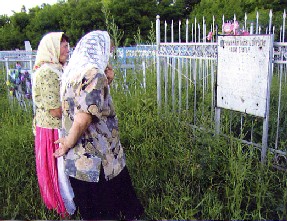 Anna Sen (left) and
Tatyana Safonova at the Petrovka cemetery.
Anna Sen (left) and
Tatyana Safonova at the Petrovka cemetery. 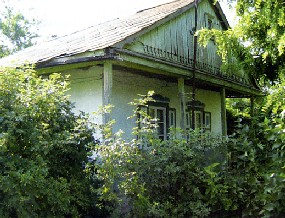
The oldest surviving Doukhobor house in Petrovka
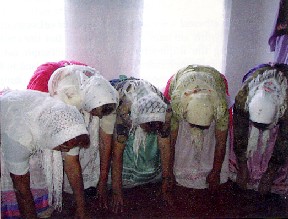
A traditional Doukhobor bow.
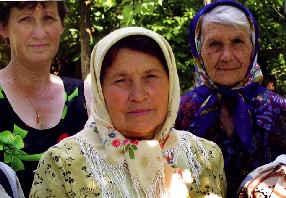
Anna Sen (Safonova), center, who helped
set up the Museum of Doukhobor Culture and Worship.
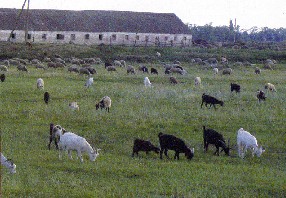
Goat and sheep herds near Khlebodarnoye. Agriculture is still the main source of income.
Doukhobors in CanadaThe Canadian government was initially sympathetic to the Doukhobors and in 1899 made exceptions to its homesteading Law to allow the sect to settle communally in Saskatchewan province on [and provided free by the State. But in 1906, the new Canadian Minister of the Interior, Frank Oliver, forced through changes that required the Doukhobors to take out separate homesteads, to individually claim title, to pledge an oath of allegiance to the British Crown and to become naturalized citizens. The Doukhobors suspected this would infringe on their beliefs and eventually end their exemption from military service.In 1907, the new regulations were enforced and 2,500 Doukhobor homesteads were cancelled. This led to a split in the Canadian Doukhobor community. The majority — The Community — followed Peter Verigin to the West Kootenays in British Columbia, where they settled on 2,700 acres of land they named Fructovo [Valley of Fruit], purchased in the name of Peter Verigin. A second group — the Sons of Freedom — went to British Columbia with Verigin, but adhered to a policy of civil disobedience and even active resistance in order that the community might return to more traditional ways. The third group — the Independents — chose to comply with the new homestead requirements, stayed behind in Saskatchewan and gradually became somewhat assimilated. The British Columbia settlers (located near Grand Forks) developed large communal enterprises (jams, jellies and honey), Lived communally and practiced their beliefs openly. Over 50 villages were initially established in the early part of the 20th century. Over time, however, as young people Left and modern life invaded, the number of villages dwindled. Today there are fewer than 20 remaining. By the end of World War II, communal Living had disappeared and assimilation into the larger Canadian society was the norm. Today, many Canadian Doukhobors are reaching out to connect with their Russian counterparts: they have brought them over for Canadian Doukhobor festivals, they are working together to open a bakery on Tostoy's former estate at Yasnaya Potyana, and there have even been intermarriages. |
| MORE INFORMATION: For a comprehensive Internet resource: Canadian Doukhobors on the web: an annotated guide Institute of Canadian Studies, Ottawa Also see: Koozma Tarasoff's website with many books about Doukhobor history: The Spirit Wrestlers News article about Tselina region Doukhobors and Molokans at the beginning of Communism: 501 Molokans & Doukhobors Perscuted in 1940s |
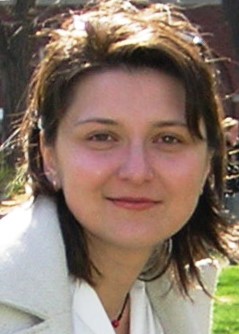
Maria Kolesnikova is a freelance writer and - most recently – managing editor for Russian Life magazine ( www.russianlife.net). Before becoming a full-time journalist, she taught in the Faculty of Philology and Journalism of Rostov State University and worked as freelance translator. She holds a master’s degree in journalism from New York University and Ph.D in media studies from Rostov State University. She’s written for New Scientist, BBC Online and other publications. — ( RAJI: On Location in Rostov, Russia (Year 4), Regular updates from the Russian-American Journalism Institute.)
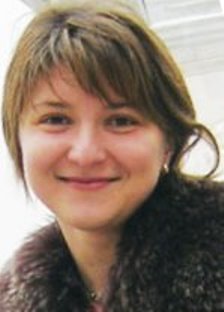
Author : Maria Kolesnikova
22 contributions found for Russian Life and/or Chtenia.
Maria Kolesnikova is a journalist who lives in Moscow and works for Bloomberg. She was a visiting scholar at New York University's Department of Journalism, and taught at the Rostov State University for seven years. For one year she was managing editor of Russian Life.
